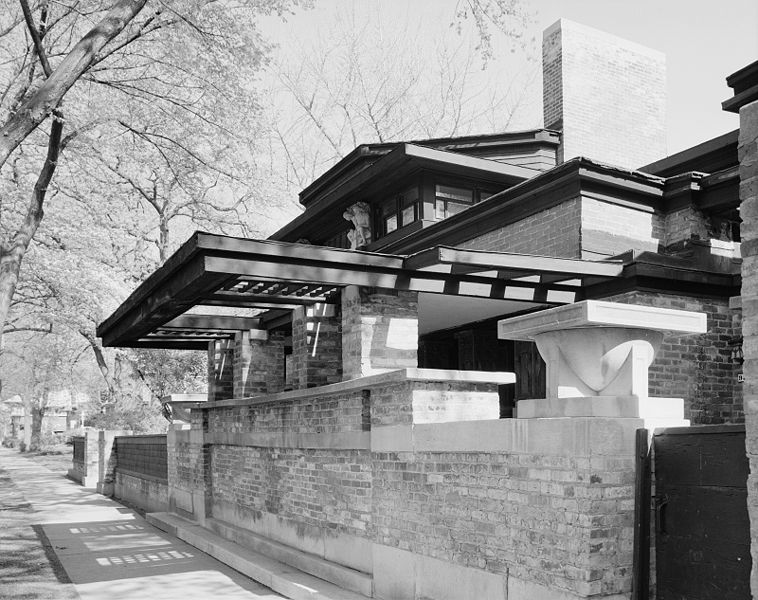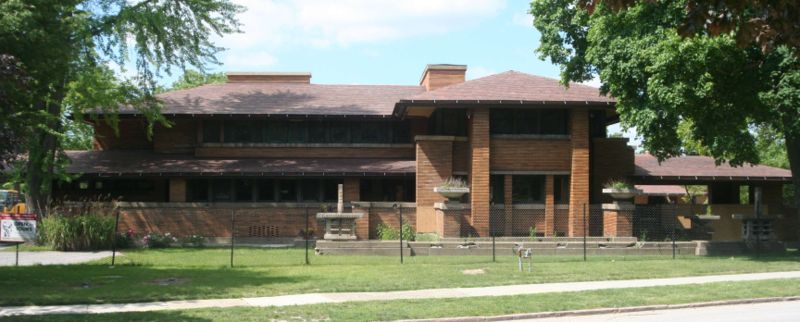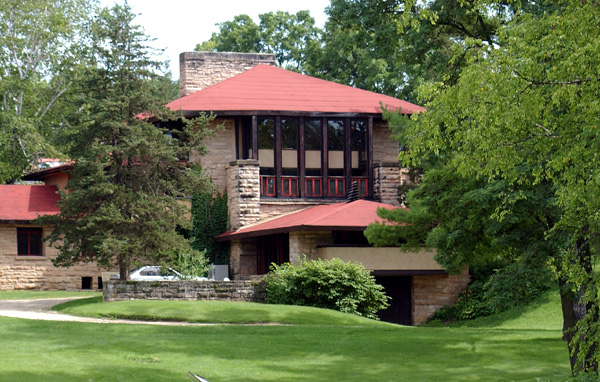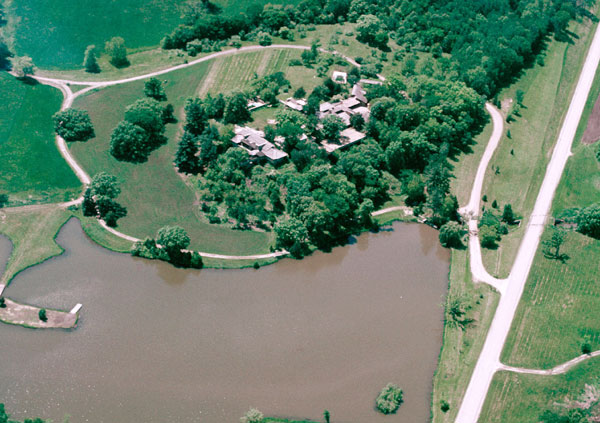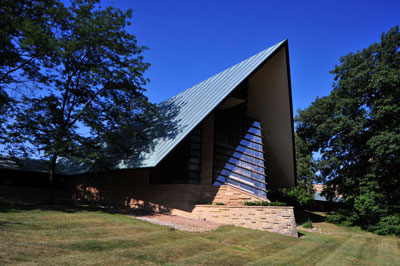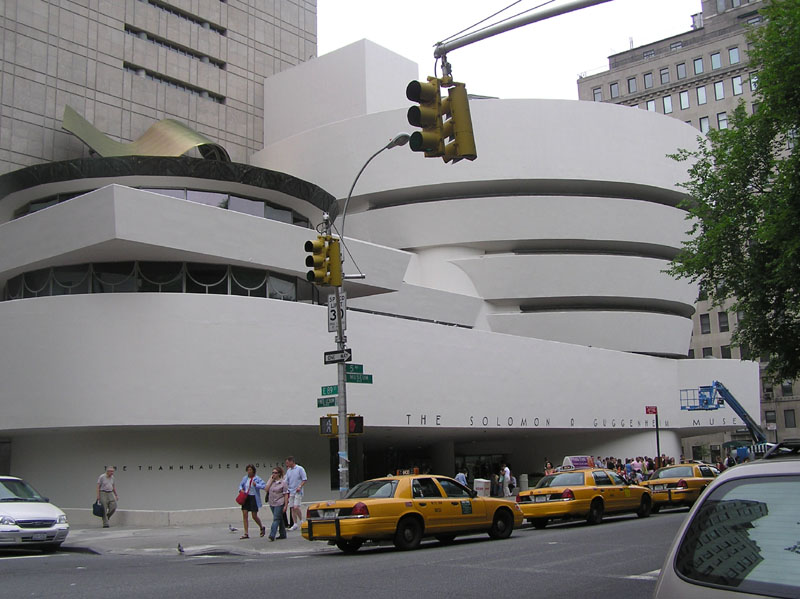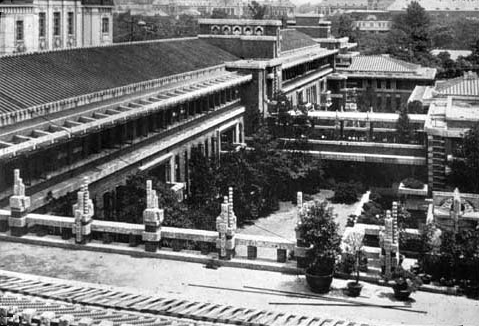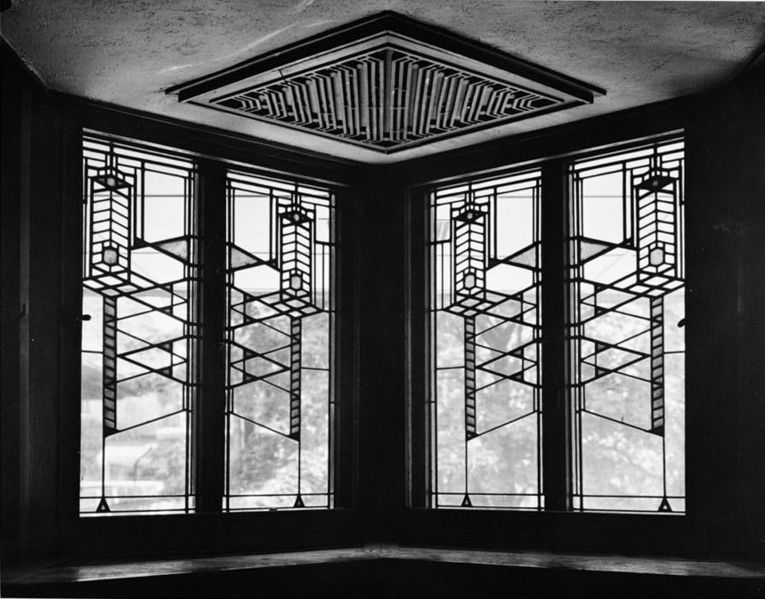<Back to Index>
- Biologist Francis Harry Compton Crick, 1916
- Architect Frank Lloyd Wright, 1867
- Second President of Indonesia Suharto, 1921


Frank Lloyd Wright (born Frank Lincoln Wright, June 8, 1867 – April 9, 1959) was an American architect, interior designer, writer and educator, who designed more than 1,000 projects, which resulted in more than 500 completed works. Wright promoted organic architecture (exemplified by Fallingwater), was a leader of the Prairie School movement of architecture (exemplified by the Robie House and the Westcott House), and developed the concept of the Usonian home (exemplified by the Rosenbaum House).
His work includes original and innovative examples of many different
building types, including offices, churches, schools, skyscrapers,
hotels, and museums. Wright also often designed many of the interior
elements of his buildings, such as the furniture and stained glass. Wright authored 20 books and many articles, and was a popular lecturer in the United States and in Europe. His colorful personal life often made headlines, most notably for the 1914 fire and murders at his Taliesin studio. Already well-known during his lifetime, Wright was recognized in 1991 by the American Institute of Architects as "the greatest American architect of all time". Frank Lloyd Wright was born in the farming town of Richland Center, Wisconsin,
United States, in 1867. Originally named Frank Lincoln Wright, he
changed his name after his parents' divorce to honor his mother's Welsh family,
the Lloyd Joneses. His father, William Carey Wright (1825 – 1904) was a
locally admired orator, music teacher, occasional lawyer and itinerant
minister. William Wright had met and married Anna Lloyd Jones (1838/39
– 1923), a county school teacher, the previous year when he was
employed as the superintendent of schools for Richland County. Originally from Massachusetts, William Wright had been a Baptist minister but he later joined his wife's family in the Unitarian faith. Anna was a member of the large, prosperous and well-known Lloyd Jones family of Unitarians, who had emigrated from Wales to
Spring Green, Wisconsin. Both of Wright's parents were strong-willed
individuals with idiosyncratic interests that they passed on to him. In
his biography his mother declared, when she was expecting her first
child, that he would grow up to build beautiful buildings. She
decorated his nursery with engravings of English cathedrals torn from a
periodical to encourage the infant's ambition. The family moved to Weymouth, Massachusetts in 1870 for William to minister a small congregation. In 1876, Anna visited the Centennial Exhibition in Philadelphia and saw an exhibit of educational blocks created by Friedrich Wilhelm August Fröbel. The blocks, known as Froebel Gifts, were the foundation of his innovative kindergarten curriculum.
A trained teacher, Anna was excited by the program and bought a set of
blocks for her family. Young Wright spent much time playing with the
blocks. These were geometrically-shaped and could be assembled in
various combinations to form three-dimensional compositions. Wright's autobiography talks
about the influence of these exercises on his approach to design. Many
of his buildings are notable for the geometrical clarity they exhibit. The Wright family struggled financially in Weymouth and returned to Spring Green, Wisconsin, where the supportive Lloyd Jones clan could help William find employment. They settled in Madison,
where William taught music lessons and served as the secretary to the
newly formed Unitarian society. Although William was a distant parent,
he shared his love of music, especially the works of Johann Sebastian Bach, with his children. Soon
after Wright turned 14 his parents separated. Anna had been unhappy for
some time with William's inability to provide for his family and asked
him to leave. The divorce was finalized in 1885 after William sued Anna
for lack of physical affection. William left Wisconsin after the
divorce and Wright claimed he never saw his father again. At
this time Wright's middle name was changed from Lincoln to Lloyd. As
the only male left in the family, Wright assumed financial
responsibility for his mother and two sisters. Wright attended a Madison high school but there is no evidence he ever graduated. He was admitted to the University of Wisconsin–Madison as a special student in 1886. There he joined Phi Delta Theta fraternity, took classes part-time for two semesters, and worked with a professor of civil engineering, Allan D. Conover. In
1887, Wright left the school without taking a degree (although he was
granted an honorary Doctorate of Fine Arts from the University in
1955). He moved to Chicago which was still rebuilding from the Great Chicago Fire of 1871, and he joined the architectural firm of Joseph Lyman Silsbee. Within a year, he left Silsbee to work for the firm of Adler & Sullivan as an apprentice to Louis Sullivan. In 1889, he married his first wife, Catherine Lee "Kitty" Tobin (1871–1959), purchased land in Oak Park, Illinois,
and built his first home, and eventually his studio there. His mother,
Anna, soon followed Wright to the city, where he purchased a home
adjacent to his newly built residence for her. His marriage to Kitty
Tobin, the daughter of a wealthy businessman, raised his social status,
and he became better known. Beginning
in 1890, he was assigned all residential design work for the firm. In
1893, Louis Sullivan discovered that Wright had been accepting private
commissions. Sullivan felt betrayed that his favored employee had
designed houses "behind his back," and he asked Wright to leave the
firm. Constantly in need of funds to support his growing family, Wright
designed the homes to supplement his meager income. Wright referred to
these houses as his "bootleg" designs; three of which (Parker, William
Gale and Thomas Gale) are located near the Frank Lloyd Wright Home and Studio,
on Chicago Avenue in Oak Park; and another two of which (Blossom and
MacArthur) are located on Kenwood Avenue in Chicago . After leaving
Sullivan, Wright established his own practice at his home. This
practice was a remarkable collection of creative architectural
designers. By 1901, Wright had completed about 50 projects, including
many houses in Oak Park. Between 1900 and 1917, his residential designs were "Prairie Houses", so-called because the design is considered to complement the land around Chicago.
These houses featured extended low buildings with shallow, sloping
roofs, clean sky lines, suppressed chimneys, overhangs and terraces,
using unfinished materials. The houses are credited with being the
first examples of the "open plan." The manipulation of interior space in residential and public buildings are hallmarks of his style. One such building is Unity Temple, the home of the Unitarian Universalist congregation in Oak Park. As a lifelong Unitarian and
member of Unity Temple, Wright offered his services to the congregation
after their church burned down in 1904. The community agreed to hire
him and he worked on the building from 1905 to 1908. He believed that
humanity should be central to all design. Many examples of this work are in Buffalo, New York as a result of friendship between Wright and Darwin D. Martin,
an executive from the Larkin Soap Company. In 1902, the Larkin Company
decided to build a new administration building. Wright came to Buffalo
and designed not only the first sketches for the Larkin Administration Building (completed in 1904, demolished in 1950), but also homes for three of the company's executives: The Westcott House was built in Springfield, Ohio,
sometime between 1907 and 1908. It not only embodies Wright’s
innovative Prairie Style design, but also reflects his passion for Japanese art and
culture in design traits characteristic of traditional Japanese design.
It is the only Prairie house built in Ohio, and represents an important
evolution of Wright’s Prairie concept. The house has an extensive
98-foot (30 m) pergola, capped with an intricate wooden trellis,
connecting a detached carriage house and garage to the main
house—features of only a few of Wright’s later Prairie Style designs. It
is not known exactly when Wright designed The Westcott House; it may
have been several months before or more than a year after Wright
returned from his first trip to Japan in 1905. Wright created two separate designs for the Westcott House; both are included in Studies and Executed Buildings of Frank Lloyd Wright, published by the distinguished Ernst Wasmuth (Germany, 1910–1911). This two-volume work contains more than 100 lithographs of Wright’s designs and is commonly known as the Wasmuth Portfolio. Other Wright houses considered to be masterpieces of the late Prairie Period (1907–1909) are the Frederick Robie House in Chicago and the Avery and Queene Coonley House in Riverside, Illinois. The Robie House, with its soaring, cantilevered roof
lines, supported by a 110-foot-long (34 m) channel of steel, is the
most dramatic. Its living and dining areas form virtually one
uninterrupted space. This building had a profound influence on young
European architects after World War I and
is sometimes called the "cornerstone of modernism". However, Wright's
work was not known to European architects until the publication of the
Wasmuth Portfolio. Local
gossips noticed Wright's flirtations, and he developed a reputation in
Oak Park as a man-about-town. His family had grown to six children, and
the brood required most of Catherine's attention. In 1903, Wright
designed a house for Edwin Cheney, a neighbor in Oak Park, and
immediately took a liking to Cheney's wife, Mamah Borthwick Cheney.
Mamah Cheney was a modern woman with interests outside the home. She
was an early feminist and Wright viewed her as his intellectual equal.
The two fell in love, even though Wright had been married for almost
20 years. Often the two could be seen taking rides in Wright's
automobile through Oak Park, and they became the talk of the town.
Wright's wife, Kitty, sure that this attachment would fade as the
others had, refused to grant him a divorce. Neither would Edwin Cheney grant one to Mamah. In 1909, even before the Robie House was
completed, Wright and Mamah Cheney eloped to Europe; leaving their own
spouses and children behind. The scandal that erupted virtually
destroyed Wright's ability to practice architecture in the United
States. Scholars
argue that he felt by 1907 that he had done everything he could do with
the Prairie Style, particularly from the standpoint of the single family house. Wright was not getting larger commissions for commercial or public buildings, which frustrated him. What
drew Wright to Europe was the chance to publish a portfolio of his work
with Ernst Wasmuth, who had agreed in 1909 to publish his work there. This
chance also allowed Wright to deepen his relationship with Mamah
Cheney. Wright and Cheney left the United States separately in 1910,
meeting in Berlin, where the offices of Wasmuth were located. The resulting two volumes, known as the Wasmuth Portfolio, were published in 1910 and 1911 in two editions, creating the first major exposure of Wright's work in Europe. Wright remained in Europe for one year (though Mamah Cheney returned to the United States a few times) and set up home in Fiesole, Italy.
During this time, Edwin Cheney granted her a divorce, though Kitty
still refused to grant one to her husband. After Wright's return to the
United States in late 1910, Wright persuaded his mother to buy land for
him in Spring Green, Wisconsin.
The land, bought on April 10, 1911, was adjacent to land held by his
mother's family, the Lloyd-Joneses. Wright began to build himself a new
home, which he called Taliesin, by May 1911. The recurring theme of Taliesin also came from his mother's side: Taliesin in Welsh mythology was a poet, magician, and priest. The family motto was Y Gwir yn Erbyn y Byd which means "The Truth Against the World"; it was created by Iolo Morgannwg who
interestingly enough also had a son called Taliesin, and the motto is
still used today as the cry of the druids and chief bard of the Eisteddfod in Wales. On August 15, 1914, while Wright was working in Chicago, Julian Carlton, a male servant from Barbados whom had been hired several months earlier, set fire to the living quarters of Taliesin and murdered seven people with an axe as the fire burned. The
dead included Mamah; her two children, John and Martha; a gardener; a
draftsman; a workman; and the workman’s son. Two people survived the
mayhem, one of whom helped to put out the fire that almost completely
consumed the residential wing of the house. Carlton swallowed acid immediately following the attack in an attempt to kill himself. He was nearly lynched on the spot, but was taken to the Dodgeville jail. Carlton died from starvation seven weeks after the attack, despite medical attention. In
1922, Wright's first wife, Kitty, granted him a divorce, and Wright was
required to wait one year until he married his then-partner, Maude
"Miriam" Noel. In 1923, Wright's mother, Anna (Lloyd Jones) Wright,
died. Wright wed Miriam Noel in November 1923, but her addiction to morphine led to the failure of the marriage in less than one year. In 1924, after the separation, but while still married, Wright met Olga (Olgivanna) Lazovich Hinzenburg, at a Petrograd Ballet performance
in Chicago. They moved in together at Taliesin in 1925, and soon
Olgivanna was pregnant with their daughter, Iovanna. Iovanna was born
December 2, 1925 and years later married and divorced Wright associate Arthur Pieper. On
April 22, 1925, another fire destroyed the living quarters of Taliesin.
This appears to have been the result of a faulty electrical system. Wright
rebuilt the living quarters again, naming the home "Taliesin III". In
1926, Olga's ex-husband, Vlademar Hinzenburg, sought custody of his
daughter, Svetlana. In Minnetonka, Minnesota, Wright and Olgivanna were accused of violating the Mann Act and arrested in October 1926. The charges were later dropped. Wright
and Miriam Noel's divorce was finalized in 1927, and once again, Wright
was required to wait for one year until marrying again. Wright and
Olgivanna married in 1928. During the turbulent 1920s, Wright designed Graycliff,
one of his most innovative residences of the period, and a precursor to
Fallingwater. The Graycliff estate was constructed from 1926 to 1929
for Isabelle and Darwin Martin on a bluff overlooking Lake Erie, just south of Buffalo, New York.
Wright designed a complex of three buildings exhibiting extensive
grounds which incorporated cantilevered balconies and terraces,
"ribbons" of windows, and a transparent "screen" of windows extracting
views of the lake into the largest building, the Isabelle R. Martin
House. Graycliff's light-filled buildings were designed in Wright's
"organic" style and were built of limestone from the beach below,
warm ochre-colored stucco and striking red-stained roofs. Wright's
designs for Graycliff's grounds incorporate water features that echo
the lake beyond: a pond, a fountain, sunken gardens and stone walls in
a "waterfall" pattern that surround the property. On the summer
solstice, Graycliff aligns with the setting sun on Lake Erie, as Wright
intended. One of Wright's most famous private residences was built from 1934 to 1937 — Fallingwater — for Mr. and Mrs. Edgar J. Kaufmann Sr., at Bear Run, Pennsylvania, near Pittsburgh.
It was designed according to Wright's desire to place the occupants
close to the natural surroundings, with a stream and waterfall running
under part of the building. The construction is a series of
cantilevered balconies and terraces, using limestone for all verticals and concrete for
the horizontals. The house cost $155,000, including the architect's fee
of $8,000. Kaufmann's own engineers argued that the design was not
sound. They were overruled by Wright, but the contractor secretly added
extra steel to the horizontal concrete elements. In 1994, Robert Silman
and Associates examined the building and developed a plan to restore
the structure. In the late 1990s, steel supports were added under the
lowest cantilever until a detailed structural analysis could be done.
In March 2002, post-tensioning of the lowest terrace was completed. Also in the 1930s, Wright first designed Usonian houses.
Intended to be highly practical houses for middle-class clients, the
designs were based on a simple but elegant geometry. He would later use
similar elementary forms in his First Unitarian Meeting House built in Madison, Wisconsin, between 1946 and 1951. Wright is responsible for a series of extremely original concepts of suburban development united under the term Broadacre City. He proposed the idea in his book The Disappearing City in 1932, and unveiled a 12-square-foot (1.1 m2)
model of this community of the future, showing it in several venues in
the following years. He went on developing the idea until his death.
The Solomon R. Guggenheim Museum in New York City occupied Wright for 16 years (1943–1959) and is probably his most recognized masterpiece. The building rises as a warm beige spiral from its site on Fifth Avenue; its interior is similar to the inside of a seashell.
Its unique central geometry was meant to allow visitors to easily
experience Guggenheim's collection of nonobjective geometric paintings
by taking an elevator to
the top level and then viewing artworks by walking down the slowly
descending, central spiral ramp, which features a floor embedded with
circular shapes and triangular light fixtures to complement the
geometric nature of the structure. Unfortunately, when the museum was
completed, a number of important details of Wright's design were
ignored, including his desire for the interior to be painted off-white.
Furthermore, the Museum currently designs exhibits to be viewed by
walking up the curved walkway rather than walking down from the top
level.
The only realized skyscraper designed by Wright is the Price Tower, a 19-story tower in Bartlesville, Oklahoma. It is also one of the two existing vertically-oriented Wright structures (the other is the S.C. Johnson Wax Research Tower in Racine, Wisconsin). The Price Tower was commissioned by Harold C. Price of the H. C. Price Company, a local oil pipeline and chemical firm. It opened to the public in February 1956. On March 29, 2007, Price Tower was designated a National Historic Landmark by the United States Department of the Interior, one of only 20 such properties in the state of Oklahoma. Concurrent to the development of Broadacre City, also referred to as Usonia,
Wright conceived a new type of dwelling unit that came to be known as
the Usonian House. An early version of the form can be seen in the Malcolm Willey House (1934) in Minneapolis; but the Usonian ideal emerges most completely in the Herbert and Katherine Jacobs First House (1937)
in Madison, Wisconsin. Designed on a gridded concrete slab that
integrated the house's radiant heating system, the house features new
approaches to construction including sandwich walls that consist of
layers of wood siding, plywood cores and building paper; a significant
change from typically framed walls. Usonian houses most commonly
feature flat roofs and are mostly constructed without basements,
completing the excision of attics and basements from houses, a feat
Wright had been attempting since the early 20th century. Designed to be
run without servants, Usonian houses commonly feature small
kitchens — called "workspaces" by Wright — that adjoin the dining
spaces.
These spaces in turn flow into the main living areas, which also are
characteristically outfitted with built-in seating and tables. As in
the Prairie Houses, Usonian living areas focus on the fireplace.
Bedrooms are typically isolated and relatively small, encouraging the
family to gather in the main living areas. The conception of spaces
instead of rooms is a development of the Prairie ideal; as the built-in
furnishings relate to the Arts and Crafts principles from which
Wright's early works grew. Spatially and in terms of their
construction, the Usonian houses represent a new model for independent
living, and allowed dozens of clients to live in a Wright-designed
house at relatively low cost. The diversity of the Usonian ideal can be
seen in houses such as the Gregor S. and Elizabeth B. Affleck House (1941) in Bloomfield Hills, Michigan, which projects over a ravine; and the Hanna-Honeycomb House (1937) in Palo Alto, California, which features a honeycomb planning grid. His
Usonian homes set a new style for suburban design that was a feature of
countless developers. Many features of modern American homes date back
to Wright; open plans, slab-on-grade foundations, and simplified
construction techniques that allowed more mechanization or at least
efficiency in building.
Wright designed over 400 built structures of which about 300 survive as of 2005. Four have been lost to forces of nature: the waterfront house for W. L. Fuller in Pass Christian, Mississippi, destroyed by Hurricane Camille in August 1969; the Louis Sullivan Bungalow, and the James Charnley Bungalow of Ocean Springs, Mississippi, destroyed by Hurricane Katrina in 2005; and the Arinobu Fukuhara House (1918) in Hakone, Japan, destroyed in the Great Kantō Earthquake of 1923. The Ennis House in California has also been damaged by earthquake and rain-induced ground movement. In January, 2006, the Wynant House in Gary, Indiana was destroyed by fire. In addition, other buildings were intentionally demolished during and after Wright's lifetime, such as: Midway Gardens (1913, Chicago, Illinois) and the Larkin Administration Building (1903, Buffalo, New York) were destroyed in 1929 and 1950 respectively; the Francis Apartments and Francisco Terrace Apartments (both located in Chicago and designed in 1895) were destroyed in 1971 and 1974, respectively; the Geneva Inn (1911) in Lake Geneva, Wisconsin, was destroyed in 1970; and the Banff National Park Pavilion (1911) in Alberta, Canada was destroyed in 1939. The Imperial Hotel, in Tokyo (1913) survived the Great Kantō earthquake but was demolished in 1968 due to urban developmental pressures.
One of his projects, Monona Terrace,
originally designed in 1937 as municipal offices for Madison,
Wisconsin, was completed in 1997 on the original site, using a
variation of Wright's final design for the exterior with the interior
design altered by its new purpose as a convention center. The
"as-built" design was carried out by Wright's apprentice Tony Puttnam.
Monona Terrace was accompanied by controversy throughout the 60 years
between the original design and the completion of the structure. A lesser known project that never came to fruition was Wright's plan for Emerald Bay, Lake Tahoe. Few Tahoe locals know of the iconic American architect's plan for their natural treasure. Wright also built several houses in the Los Angeles area. Currently open to the public are the Hollyhock House (Aline Barnsdall Residence) in Hollywood and the Anderton Court Shops in Beverly Hills. Following the Hollyhock House, Wright used an innovative building process in 1923 and 1924, which he called the textile block system where buildings were constructed with precast concrete blocks with a patterned, squarish exterior surface: The Alice Millard House (Pasadena), the John Storer House (West Hollywood), the Samuel Freeman House (Hollywood) and the Ennis House in
the Griffith Park area of Los Angeles. During the past two decades the
Ennis House has become popular as an exotic, nearby shooting location
to Hollywood TV and movie makers. He also designed a fifth textile
block house for Aline Barnsdall, the Community Playhouse ("Little
Dipper"), which was never constructed. Frank Lloyd Wright's son, Lloyd Wright,
supervised construction for the Storer, Freeman and Ennis House. Most
of these houses are private residences and closed to the public because
of renovation, including the George Sturges House (Brentwood) and the Arch Oboler Gatehouse & Studio (Malibu). Oak Park, Illinois,
a Chicago suburb, has the largest collection of Wright houses, as well
as Wright's home and studio, which are open for public tours. Tours of
certain homes occur during the year. The Unity Temple is located on
Lake Street in Oak Park. The Cheney House, Edwin and Mamah Cheney's
residence, has been a bed and breakfast for many years. Beside the home's beauty, it contains a stunning in-law suite on the lower level. Florida Southern College, located in Lakeland, Florida, constructed 12 (out of 18 planned) Frank Lloyd Wright buildings between 1941 and 1958 as part of the Child of the Sun project. The Kalita Humphreys Theater in Dallas, Texas was Wright's last project before his death. Gordon House is Wright's last Usonian design which was completed in 1963. It is open for public access at the Oregon Garden.
A design that Wright signed off on shortly before his death in 1959 –
possibly his last completed design – was realised in late 2007 in the Republic of Ireland. Wright scholar and devotee Marc Coleman worked closely with the Frank Lloyd Wright Foundation,
dealing with E. Thomas Casey, the last surviving Foundation architect
who trained under Wright. Working with the Foundation, Coleman selected
an unbuilt design that was originally commissioned for Mr. and Mrs.
Gilbert Wieland and due to be built in Maryland,
USA. However, the Wielands subsequently had financial problems and the
design was shelved. The Foundation looked through its archive of 380
unbuilt designs and selected 4 for Coleman that were the closest fit
for his site. In the end, he chose the Wieland house, largely because
the topography of his site is virtually identical to that which the building was originally designed for. The completed house, in
only the fourth country in which a Wright design has been realised, is
attracting broad interest from the international architectural
community. Casey visited the site in County Wicklow, but died before
construction began. Frank
Lloyd Wright was interested in site and community planning throughout
his career. His commissions and theories on urban design began as early
as 1900 and continued until his death. He has 41 commissions of a scale
that can be considered community planning or urban design. His thoughts on suburban design started in 1901 with an article in Ladies Home Journal.
The article was designed to showcase “New Series of Model Suburban
Houses Which Can Be Built at Moderate Cost”. Wright not only submitted
a home design, but even proposed the Quadruple Block Plan as a proposed
subdivision layout. This
design strayed from traditional suburban lot layouts and set houses on
small square blocks of four equal-sized lots surrounded on all sides by
roads. The houses were set toward the center of the block so that each
maximized the yard space and included private space in the center. This
also allowed for far more interesting views from each house. This
design would have eliminated the straight rows of houses on parallel
streets with boring views of the front of each house. His first
commission using the Quadruple Block Plan was for Charles E. Roberts in
1903, and Wright continued to push his concept in many of his large
scale designs through the end of his career. The
more ambitious designs of entire communities were exemplified by his
entry into the City Club of Chicago Land Development Competition in
1913. The contest was for the development of a suburban quarter
section. This design expanded on the Quadruple Block Plan and included
several social levels. The design shows the placement of the upscale
homes in the most desirable areas and the blue collar homes
and apartments separated by parks and common spaces. The design also
included all the amenities of a small city: schools, museums, markets,
etc. This view of decentralization was later reinforced by theoretical Broadacre City design.
The philosophy behind his community planning was decentralization. The
new development must be away from the cities. In this decentralized
America, all services and facilities could coexist “factories side by
side with farm and home.” Notable Community Planning Designs: 1901 – Quadruple Block Plan – “Ladies Home Journal” February 1901, April 1901 Though most famous as an architect, Wright was an active dealer in Japanese art, primarily ukiyo-e woodblock prints.
He frequently served as both architect and art dealer to the same
clients; "he designed a home, then provided the art to fill it". For a
time, Wright made more from selling art than from his work as an
architect. Wright
first traveled to Japan in 1905, where he bought hundreds of prints.
The following year, he helped organize the world's first retrospective
exhibition of works by Hiroshige, held at the Art Institute of Chicago. For
many years, he was a major presence in the Japanese art world, selling
a great number of works to prominent collectors such as John Spaulding of Boston, and to prominent museums such as the Metropolitan Museum of Art in New York. He penned a book on Japanese art in 1912. In
1920, however, rival art dealers began to spread rumors that Wright was
selling retouched prints; this combined with Wright's tendency to live
beyond his means, and other factors, led to great financial troubles
for the architect. Though he provided his clients with genuine prints
as replacements for those he was accused of retouching, this marked the
end of the high point of his career as an art dealer. He was forced to sell off much of his art collection in 1927 to pay off outstanding debts; the Bank of Wisconsin claimed his Taliesin home the following year, and sold thousands of his prints, for only one dollar a piece, to collector Edward Burr Van Vleck. Wright
continued to collect, and deal in, prints until his death in 1959,
frequently using prints as collateral for loans, frequently relying
upon his art business to remain financially solvent. The
extent of his dealings in Japanese art went largely unknown, or
underestimated, among art historians for decades until, in 1980, Julia Meech,
then associate curator of Japanese art at the Metropolitan Museum,
began researching the history of the museum's collection of Japanese
prints. She discovered "a three-inch-deep 'clump of 400 cards' from
1918, each listing a print bought from the same seller — 'F. L. Wright'"
and a number of letters exchanged between Wright and the museum's first
curator of Far Eastern Art, Sigisbert C. Bosch Reitz, in 1918 to 1922. These discoveries, and subsequent research, led to a renewed understanding of Wright's career as an art dealer.
Turmoil followed Wright even many years after his death on April 9, 1959. His third wife, Olgivanna, ran the Fellowship after Wright's death, until her own death in Scottsdale, Arizona in
1985. In 1985, it was learned that her dying wish had been that Wright,
she and her daughter by a first marriage all be cremated and relocated
to Scottsdale, Arizona. By then, Wright's body had lain for over 25 years in the Lloyd-Jones cemetery, next to the Unity Chapel, near Taliesin, Wright's later-life home in Spring Green, Wisconsin. Olgivanna's
plan called for a memorial garden, already in the works, to be finished
and prepared for their remains. Although the garden had yet to be
finished, his remains were prepared and sent to Scottsdale where they
waited in storage for an unidentified amount of time before being
interred in the memorial area. Today, the small cemetery south of
Spring Green, Wisconsin, and a long stone's throw from Taliesin,
contains a gravestone marked with Wright's name but its grave is empty.
1903 – Charles R. Roberts – 24 homes – Oak Park, IL
1909 – Como Orchard Summer Colony – Town site development for new town in the Bitterroot Valley, MT
1913 – Chicago Land Development competition – Suburban Chicago quarter section
1934–1959 – Broadacre City – Theoretical decentralized city plan – exhibits of large scale model
1938 – Suntop Homes also known as Cloverleaf Quadruple Housing Project – commission from Federal Works Agency, Division of Defense Housing – low cost multifamily housing alternative to suburban development
1945 – Usonia Homes – 47 homes (3 designed by Wright himself) in Pleasantville, New York
1949 – The Acres, also known as Galesburg Country Homes, 5 homes (4 designed by Wright himself) in Charleston Township, Michigan
